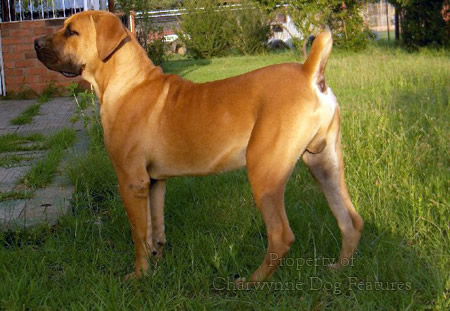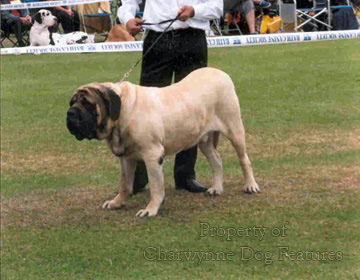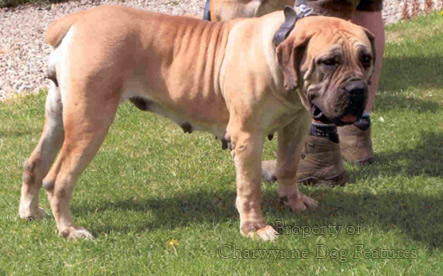220 BREEDING BETTER MASTIFF BREEDS
BREEDING BETTER MASTIFF BREEDS
by David Hancock
 Inheritance
Inheritance
“An understanding of pedigrees and the existing bloodlines, the willingness to cooperate with one another, and the determination to eliminate the mentally and physically unsound individuals from any breeding program are the first steps to be taken towards establishing a worthwhile strain of Mastiff which should stand high on the list of Working breeds.”
From The Mastiff by Marie Antoinette Moore (Denlinger, Virginia, USA) of 1928.
"The breed does not seem to have made the improvements I personally would have liked to have seen it make in the last 15 years or so...I am saddened by the loss of type; where are the square heads, deep broad muzzles and good spring of rib?...I am sure that if we can recapture the old dedication and enthusiasm and watch breeding lines carefully we can return to the breed's former glory. Just because you have a Mastiff that may have won well does not necessarily mean it has to be bred from."
From The Mastiff Today by Lyn Say, Our Dogs, June, 2000.
Selecting Good Genes
The selection of mates will forever be the principal factor in successful livestock breeding. So often, in the working dog world, it's done on a work-rating: how good at working are the prospective parents? In the show dog world, however often this is denied, rosette-winning is the biggest single factor, with even unworthy Crufts winners being freely used as breeding stock. This is an entirely irrational act; it is based on a view that, firstly, Crufts judges are trustworthy in their judgements, secondly that the winning dog is physically and mentally sound, and thirdly, that the chosen mate will actually 'nick' with the other mate. By that I mean, produce the quality offspring the blood behind each mate should create. As master- breeder Jocelyn Lucas wrote in his Pedigree Dog Breeding (Simpkin, 1925): "A stud dog is not good just because he is good looking. He must be bred right and not be 'chance got', or his good points will not force themselves on his progeny."
Being ‘Chance Got’
Far too many pedigree pups are 'chance got', any success coming from luck, or bred in hope not to a plan. Charles Castle FZS, in his Scientific Dog Management and Breeding (Kaye, 1951), wrote: "Bruce-Lowe traced the pedigree of every racehorse back to the original dam...he was able to classify these families by their characteristics, such as 'sire- producing families', 'running families', etc...these families run true to the present day, passing on family characteristics and certain families 'nick in' to each other to produce winners..." There, was a serious enlightened breeder. As vet and exhibitor RH Smythe wrote in his informative The Breeding and Rearing of Dogs (Popular Dogs, 1969): "It is true that some kennels contrive to turn out a champion each year, but they are usually those that contain a number of bitches often similarly bred, and their owners have been fortunate enough to discover a sire that 'nicks'..." This system has a run-out date as repeat close-breeding can penalise in time; breeding closely is a skill, not an opportunity.
Breeding livestock is very much a science, but a good breeder makes it into an art. There are some show dog breeders with gifted insight. In the Bullmastiff world, for example, distinguished and highly successful kennels like Oldwell and Bunsoro, have long excelled at sire selection and choice of darn. Some of their very best dogs have not come from high winning parents. Some quite sound but not truly outstanding dogs sire high standard offspring, as Bunsoro Bymesen, top sire in 2005, and Azer of Oldwell, who never became a champion but sired nine, illustrate. It is the blend of phenotypical and genotypical features which produce the offspring; top quality can skip a generation. The concept that a Crufts winner mated to an indifferent bitch can somehow produce top quality pups is seriously flawed. It is based on wishful thinking not science. The lazy thinking which leads to a good quality Bullmastiff bitch being mated to the nearest available Bullmastiff sire is just puppy-producing. If I were buying a Boerboel I would approach a dedicated breeder like Peter Wilson, who, in his diligent quest for quality toured the Boerboel kennels in South Africa, before he came across stock with the mental and physical attributes he was seeking. That is serious enlightened intent. All too often 'dogs only good on their papers' or pedigree-irnpressive dogs are assumed unwisely to be valuable breeding material. This is not wise.
Respecting a Breed
In dog breeding, the written pedigree has a role, but should never ever be the deciding factor. Without the written pedigree declaring health details, how can anyone know the genetic health of the dog? The written pedigree can mis-instruct; if you believe that it accurately sets out a dog's ancestors, then you are naive. Far too many written pedigrees are accepted at face-value; no DNA checks are routinely made to verify accuracy. I know of well-known breeders offering stud-dog A at a fat fee, but actually employing kennel-dog B, a better performer. It is fraudulent but it happens. The Danish geneticist Winge proved on coat-colour grounds alone that 15% of the Danish KC pedigrees were untrue. A serious breeder is an assiduous researcher. Honest breeding records are of course immensely valuable but it takes skill to read them rewardingly.
Far too many breeds of purebred dog are 'overdone': Beardies, Rough Collies, Shelties, Bull Terriers, Bulldogs, Mastiffs, Fox Terriers, Dachshunds and Basset Hounds are, in my view. Selective breeding for show points has gone too far. Some Bullmastiff heads are 'overdone'. In the new edition of my book The Bullmastiff, A Breeder's Guide, I show over a hundred illustrations of the pre-war breed; which is the true head for the breed? The Bullmastiff is sometimes unwisely described as 'a head breed'; 'overdone' heads exaggerate themselves. But it would take a brave soul within the breed to attempt redress. Soon there were be a generation, if there isn't one already, that doesn't know what their breed once looked like. So much for respecting a breed and its functional origin. In The Principles of Dog-Breeding (Toogood, 1930) RE Nicholas wrote: "The breeder who returns from each show with a new rather than an improved ideal seldom accomplishes anything worthwhile, for vacillation in standards is the direct road to confusion of types and to absolute failure. The rolling stone gathers nothing but hard knocks." Every breed needs breed-architects ahead of breed optimists.
Loss of Basic Soundness
When you breed, selectively for coat, as has happened in the Beardie, the Rough Collie and the Sheltie, you can end up with all coat and no dog. When you breed, selectively, for head-shape, you lose genuine type, as in the Bullmastiff and the Bulldog, no matter how widely accepted the new look is. When you breed, selectively, for 'stance', substance and excess of breed features, as in the Dogue de Bordeaux, the Mastiff and the Neapolitan Mastiff respectively, you betray the breed's heritage and don't always put the well-being of the dog ahead of slavish perpetuation. Breeds which feature the over-heavy head are so often unbalanced, especially on the move, as the dog's centre of gravity is shifted. Regrettably, overseas judges and all-rounders see loss of basic soundness and true type quicker than breed specialists, although it is more a matter of honesty than eyesight. Over half a century ago, as a vet's kennel boy, I went with him to Molly Harbut's Airedales, to Manson Baird's Deerhounds, Miss Lipscombe's Bull Terriers and other renowned kennels; it would be good to see such 'type' once more.
It is perfectly possible to breed selectively for soundness. All sporting and working breeds were created that way. The soundest breed I see in the show ring, abroad admittedly, is the American Staffordshire Terrier. They are unexaggerated, supremely fit, superbly constructed, uniformly typy and impressively 'like themselves'; they look, even in a ring of thirty, as though they all came from the same dam. A class of Bullmastiffs at a championship show a few years ago was described by the judge as 'any variety Bullmastiff'. American Bulldogs can look very different, one from another, as different kennels favour different types. But each appears to have been selectively bred to be a canine athlete. When I judged a class a few years ago (see report in later section), type was varied but soundness still manifested itself. Selectivity wasn't working towards one design but still producing sound construction. A dog of this size too, which is Bullmastiff size, must be bred with temperament in the forefront of the breeder's mind.
Constructed by Boasters
Of all the pedigree breeds of dogs failed by their fanciers, and it would make quite a long list, the mastiff breeds sadly come high on the list. The English Mastiff has become prized for its giant size – not for anything the breed can do! The Bulldog is preferred as a caricature of itself – with its fanciers still claiming it could ‘pin’ a bull! The Bullmastiff is all too often bred like a huge Bulldog, rather than a blend of Mastiff and Bulldog, with the latter’s blood featuring less, as was the original intention. The Neapolitan Mastiff so often displays excessive skin and needlessly heavy bone. The Boerboel, at the last breed event I attended, was being prized for its massiveness not its power and athleticism. The Dogue de Bordeaux regularly exhibits too long a body and legs lacking length, with more than a hint of eye problems in the making. The Great Dane or German Mastiff has become valued for its immense shoulder height ahead of its soundness. Far too many Filas are too bloodhoundy to be true to their own breed type. Are these fair criticisms from someone ‘outside’ these breeds or from an honest observant critic with their best interests at heart? A veterinary surgeon friend once described the breeders of huge dogs as ‘status-seeking size-boasters’; he may have had a point. Earlier I have set out the perils of breeding dogs that are too heavy for their own good, too short-muzzled for their well-being and harmfully heavy-boned. Here, I stress the significance of the key features in a strongly-made but essentially active type of dog and emphasize the danger arising from show ring fads. 
Needless Bulk
Bigger doesn't always mean better, especially in the dog-breeding world. In the past few years, I have attended dog shows in which dogs have been proudly presented by exhibitors when they were clearly just too big for their own well-being; this is not wise. Breeds like the Boerboel, the Bullmastiff, the Dogue de Bordeaux, the Neapolitan Mastiff and the Mastiff were never intended to be admired and valued because of their size but for what they could do. The Boerboel is and was the South African 'farmer's bulldog', needed to drive wayward bulls, protect livestock from predators and lead a full life on a vast farmstead. It was not designed to pull carts or engage in weight-pulling contests of little consequence. It was always an active working dog. Similarly, the Bullmastiff was bred to be active and powerful not inactive and immense. A Bullmastiff weighing more than 130lbs breaches its own breed standard and should not even be seen by a judge. Why breed away from function when it always creates problems and leads to a loss of true breed type?
A couple of years ago, I watched the Mastiff of England being exhibited by foreigners at a World Dog Show. It made me quite angry. The dogs were so unsound, so demeaning in a once-distinguished breed - slothful, shambling, grossly overweight specimens of a fine breed 'gone wrong'. Their movement was quite dreadful; their construction so unsound; their eyes deeply-sunken and dull; their flews exaggerated beyond comfort and their ultra-heavy bone a needless handicap. I was appalled. Any group of breed fanciers can lose their way, but when a dog of this size is ill-bred, indirect cruelty is involved. These dogs were heavier than any past function could ever justify; they appeared to be valued because of their extreme bulk.
Writing in 'The Book of the Dog' of 1948, edited by Brian Vesey-Fitzgerald and published by Nicholson and Watson, Arthur Croxton Smith gave this view: "Breeders seem to have concentrated more and more upon getting immense size, and great bulk usually brings the evil of unsoundness in its train. I have seen plenty of perfectly sound mastiffs, such as could move well and were really active, but latterly the proportion of unsound ones has been alarmingly heavy, for it is extremely difficult for breeders to get soundness in alliance with bulk." No breed can lead a healthy life if its whole design is at the mercy of human whim. Any breed no longer bred for a function, even if that function has lapsed, has a doubtful future.
Resultant Problems
If youthen look at the health of the breed as summarised in an authoritative book such as 'Medical and Genetic Aspects of Purebred Dogs' by Clark and Stainer (1994), youcan see some of the problems in the breed. It states: "Many bitches experience uterine inertia after whelping one or two puppies, probably resulting from the breed's characteristic lethargy...Obesity is the curse of the Mastiff breed...many owners continue to overfeed their dogs in the mistaken belief that the heavy feeding increases the dog's size." Far too many of the show ring Mastiffs cannot live an active life, they are simply too heavy, and they do not lead active lives. They can damage themselves just getting out of a car. No dog should be bred so heavy that it cannot live like a normal dog. No dog should be bred with built-in anatomical handicaps. In the pursuit of great size, many Mastiff owners overfeed and over-supplement their young dogs with vitamins and minerals. Obesity is a major threat to the well-being of Mastiffs. Any dog weighing nearly 200lbs desperately needs the soundest of physiques just to ensure a fulfilling life.
Lethargy and obesity from overfeeding, are these not the consequences of breeding for great size without accompanying soundness or quality? I groan when I read a judge's critique praising 'great bone'; are we breeding cart-horses or powerfully-built physically-sound dogs? The seeking of massive bone in any breed of dog is not a rational act. Strong, flat bone is admired by every racehorse owner, because it is the strongest, and who in all honesty wants a dog with thick ankles? Of what use and value are they to the dog? Did our distant ancestors, who actually used these dogs in the field, ever value a dog purely for its bulk? The Mastiff of England is an imposing breed, developed because of its athleticism not its size; now a veterinary author refers to "the breed's characteristic lethargy". It is dishonest to boast of a breed's historic feats and then breed an animal that simply could not accomplish such a task.
Strange Desire for Harmful Bulk
The weight of a dog has to be related to function not show ring whim. We should all be proud of the athleticism of our mastiff breeds not make meaningless boasts about their needles bulk. I attended a Bullmastiff seminar twenty years ago, where the principal speaker argued that to be a successful nightdog the dog had to weigh over 120lbs and had no need to be able to jump fences or stone walls! The most successful nightdog was Thorneywood Terror and he weighed 90lbs. His owner, W Burton, wrote on nightdogs that "He ought to be able to jump a gate with ease." Another famed nightdog 'Osmaston Daisy' weighed 88lbs. The esteemed pioneer breeder Moseley always stressed that a Bullmastiff should be active. His 'Farcroft Fidelity' was described by the knowledgeable Robert Leighton in 1924 as being as "active as a terrier, with hindquarters that would not disgrace an Alsatian". Sadly there are many Bullmastiffs lacking 'activity' in the 21st century.
"The Bull Mastiff is, or should be, a light heavy-weight..."
Arthur Craven FZS Dog World August 1932